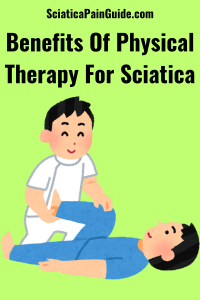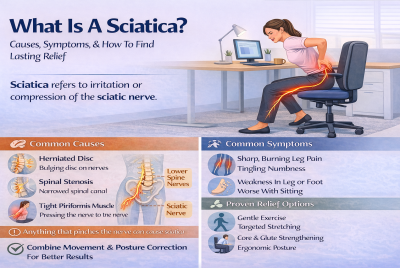Benefits of Physical Therapy for Sciatica
Discover the benefits of physical therapy for sciatica. Learn how it reduces pain, improves mobility, and prevents future episodes. If you’ve ever experienced sciatica, you know how debilitating it can be. The shooting pain that runs from your lower back down through your leg can be relentless. As someone who’s advised many on managing sciatica, I’ve seen firsthand how effective physical therapy can be in providing relief. But what exactly makes physical therapy such a game-changer for sciatica? Let’s dive into it.
Understanding Physical Therapy
Before we get into the specifics of how physical therapy can help with sciatica, let’s clarify what physical therapy is. In simple terms, physical therapy is a treatment method that uses exercises, manual manipulation, and other techniques to help improve movement, reduce pain, and restore function. Unlike medications that just mask the pain or surgeries that are invasive, physical therapy targets the root of the problem.
Why Choose Physical Therapy for Sciatica?
You might wonder why physical therapy is often recommended for sciatica. There are several compelling reasons. Firstly, physical therapy offers personalized treatment plans. Your physical therapist will assess your specific condition and design a plan that targets your pain points. Secondly, it’s a non-invasive option. There are no needles and no surgeries—just natural, guided movements and treatments.
Physical Therapy Treatments
How to Stretch for Sciatica Nerve Pain
Key Benefits of Physical Therapy for Sciatica
Pain Reduction
One of the most significant benefits of physical therapy for sciatica is pain reduction. Therapists use various techniques like manual therapy and neuromuscular re-education to alleviate pain. These methods can help reduce inflammation, release muscle tension, and improve blood flow—all of which contribute to less pain.
Improving Mobility
When sciatica hits, even simple movements can be painful. Physical therapy focuses on stretching and strengthening exercises that help improve mobility. By targeting the muscles in your back, hips, and legs, these exercises can make it easier to move without pain. Think of it as giving your body the tools it needs to move freely again.
Enhancing Flexibility
Flexibility might not be the first thing that comes to mind when you think about sciatica, but it plays a crucial role. Tight muscles can aggravate sciatic pain. Physical therapists will guide you through flexibility exercises that lengthen these muscles, reducing pressure on the sciatic nerve. It’s like giving your body a good stretch after a long day—relieving and refreshing.
Speeding Up Recovery
No one wants to be sidelined by sciatica for long. Physical therapy offers a way to speed up the recovery process. Through a gradual progression of exercises and treatments, you can often see improvements in weeks rather than months. Consistent sessions help your body adapt and heal, getting you back to your regular routine faster.
Preventing Future Episodes
One of the most underrated benefits of physical therapy is its role in prevention. Physical therapists don’t just focus on current pain; they also teach you long-term strategies to prevent future episodes. This could include ergonomic advice, posture correction, and specific exercises that strengthen your core and back.
Common Physical Therapy Techniques for Sciatica
Manual Therapy
Manual therapy includes techniques like massage, mobilization, and manipulation to reduce pain and improve function. These hands-on methods can help release tight muscles and improve joint movement.
Exercise Therapy
Exercise is the cornerstone of physical therapy for sciatica. Your therapist will guide you through a series of exercises that target the muscles contributing to your pain. This might include core strengthening, leg lifts, and low-impact aerobic exercises.
Heat and Cold Therapy
Using heat and cold therapy is a simple yet effective way to manage sciatica pain. Heat can relax tight muscles, while cold can reduce inflammation. Physical therapists often use these techniques to complement exercise therapy.
What to Expect During Physical Therapy Sessions
Initial Assessment
Your first session will typically involve an initial assessment. Here, your therapist will ask about your symptoms, medical history, and specific pain points. They may also perform some physical tests to understand your range of motion and identify muscle weaknesses.
Ongoing Treatment Plan
Based on the assessment, your therapist will create a treatment plan tailored to your needs. This plan will include a mix of exercises, manual therapy, and other modalities. Your progress will be monitored regularly, and adjustments will be made as necessary.
Finding the Right Physical Therapist
Choosing the right physical therapist is crucial for your recovery. Look for therapists with credentials like a Doctor of Physical Therapy (DPT) and those who have experience in treating sciatica. Don’t be afraid to ask questions about their experience and approach to treatment.
Combining Physical Therapy with Other Treatments
While physical therapy is highly effective, it can be even more powerful when combined with other treatments.
Chiropractic Care
Chiropractors can offer spinal adjustments that complement the work done in physical therapy. Together, these treatments can provide a more holistic approach to pain relief.
Pain Management Techniques
In some cases, physical therapy may be combined with pain management techniques such as medications or injections, especially if the pain is severe. Your healthcare provider will work with your physical therapist to ensure that all treatments align.
Home Exercises and Self-Care
Physical therapy doesn’t end when you leave the clinic. Therapists will often prescribe home exercises to ensure you continue making progress. Following these recommendations is key to maintaining the benefits of your in-clinic sessions.
Real-Life Success Stories
I’ve heard from many individuals who’ve seen incredible results with physical therapy. Take John, for example. He had been struggling with sciatica for months and was skeptical about physical therapy. After a few weeks of consistent sessions, he noticed a significant reduction in pain and an increase in mobility. Stories like John’s are common, proving that physical therapy can make a real difference.
FAQs Related to Benefits of Physical Therapy for Sciatica
Can physical therapy cure sciatica completely?
Physical therapy can significantly reduce or even eliminate sciatica symptoms, but it may not be a permanent cure. Consistent therapy and lifestyle changes can help manage and prevent future pain.
How long does it typically take to see results from physical therapy?
Results can vary, but many people start to see improvement within a few weeks of regular therapy. The key is consistency and following your therapist’s recommendations.
Is physical therapy safe for everyone with sciatica?
Yes, physical therapy is generally safe for most people. However, it’s essential to work with a qualified therapist who can tailor treatments to your specific condition.
How often should I attend physical therapy sessions?
The frequency of sessions can vary. Some may benefit from attending two to three times a week, while others may only need weekly visits. Your therapist will provide a schedule based on your needs.
What should I wear to a physical therapy session?
Wear comfortable, loose-fitting clothing that allows you to move freely. Athletic wear like shorts, leggings, and T-shirts is usually ideal.
Can I do physical therapy exercises at home?
Absolutely! Your therapist will likely give you exercises to do at home to complement your in-clinic sessions. These exercises are crucial for maintaining progress.
Benefits of Physical Therapy for Sciatica – Conclusion
If you’re struggling with sciatica, physical therapy offers a non-invasive, effective way to manage and reduce your pain. By working with a qualified physical therapist, you can develop a personalized treatment plan that not only alleviates your current discomfort but also helps prevent future episodes. Remember, the journey to recovery is a step-by-step process, but with physical therapy, you’re on the right path to relief.
Disclaimer
This article is for informational purposes only and is not a substitute for professional medical advice, diagnosis, or treatment. Always consult with your healthcare provider before starting a new exercise or stretching routine, especially if you have existing back or nerve conditions.
👉 Explore more:





